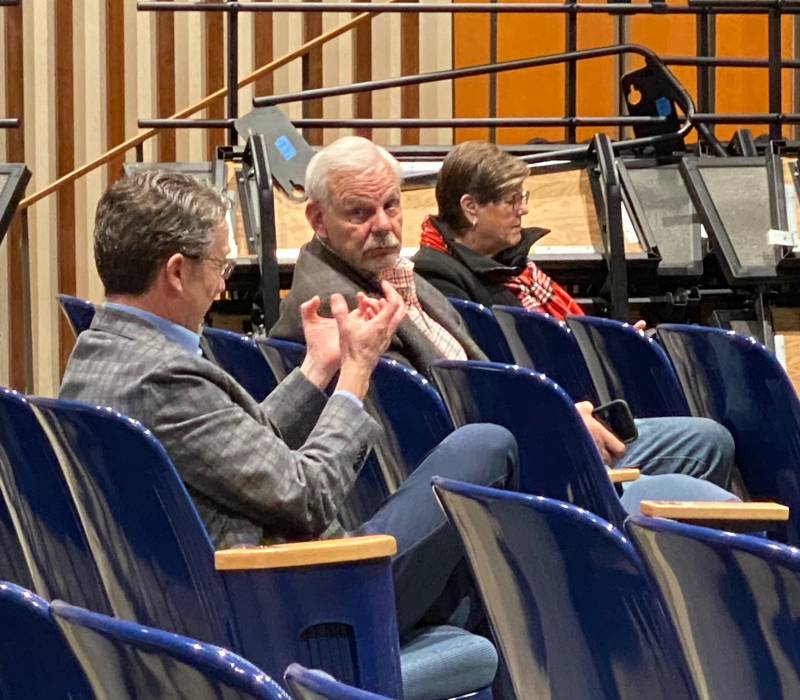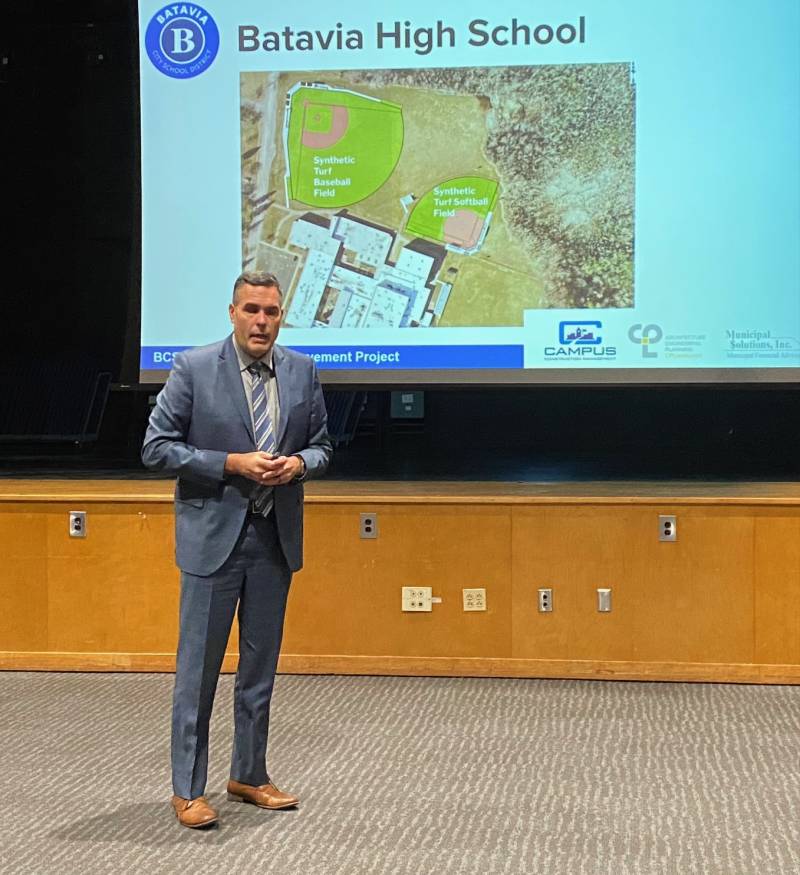
Photo by Joanne Beck
Of the nine people at Thursday’s Batavia City Schools capital project public hearing, only one was a district resident who came to hear the presentation.
The remaining people in the auditorium were district staff, board members and an architect from the project design team. Although Herb Schroeder was the lone attendee, he came armed with a list of questions about the $45 million district-wide project.
Is this being paid for with a grant?
No. $6.9 million is coming from capital reserves, and the remainder of $38 million from a loan, to be paid back with reimbursement from the state.
What if the state reneges? It’s a lot for the taxpayers to handle if the state reneges.
None of the presenters had ever heard of the state backing out of its commitment to reimburse a district for a capital project. These projects must be approved by the state Education Department after voter approval.
Have you looked into the price of traditional turf (in addition to the artificial turf that’s part of the capital project)?
No. Superintendent Jason Smith wasn’t saying that he wouldn’t look into it, but from everything that coaches and the Clark Patterson Lee team have advised, artificial is the way to go to help address the drainage issues with the fields at Batavia High School, Smith said.
“Drainage issues are going to be a problem no matter what you do … it’s a lot of money, that’s my biggest pet peeve,” Schroeder said.
Even professional associations are considering going back to natural turf after some athletes have gotten injured on the artificial material, he said.
The plan calls for two synthetic turf fields for the high school, a baseball and softball field each, for about $7 million of the total cost. A proposed turf field at Van Detta Stadium upset a fair number of people — prospective tax-paying voters — so The Batavian had previously asked Smith why turf for the high school.
The fields behind the State Street site have been prone to excess water and drainage issues for years, he said, since the school was built on a swamp. “We have received complaints from families,” he said and had to move several games to Genesee Community College as a result.
Synthetic turf raises the playing field, alleviates pooling water, and provides “a better quality playing field for the kids,” he said. Installing this type of material would permanently fix the swamping issue, he said.
“Most of us don’t see it as a luxury anymore,” he said.
Robert Morris was closed in 2011 due to declining enrollment, so what are your projections for the next five years?
Enrollment is flat, with a slight increase at Robert Morris with the universal pre kindergarten, pre-school and pre-school special education programs enrolling kids ages 3 to 5.
After using the one reserve for this project, are there any reserves left?
Yes and no, Smith said.
“Man, that’s a politician,” Schroeder said with a small chuckle.
Business Administrator Andrew Lang explained that there are some reserves already in place, including a teacher’s and employee’s retirement system reserve, and a reserve that the district created this past budget season to begin building up an account for future needs. This project, however, will drain this one particular reserve of $6,928,000.
A shift from getting a grant to borrowing the money “scares me,” Schroeder said, but he pledged his support.
“I’m going to vote for your project,” he said.
This was the second presentation in the last two weeks, with the first one drawing only about three or four people. Board President John Marucci isn’t concerned about the low attendance. In fact, he believes it’s a testament to the district’s competence in disseminating the information and answering questions sufficiently before next week's vote.
“I guess I was a little worried walking in and seeing that there's only one person here. But the more I thought about it, the more I think the community is comfortable with the job that we did. They're happy with what we've done. And I think the vote next week will show that it'll pass with flying colors,” Marucci said. “If this would have been a full auditorium, I would have been real worried. Just because that would tell me that, I think, there might be some people that have some real questions on the job we've done. I think just seeing the one gentleman here tonight asking some great questions, that just showed that I think the community has paid attention to the flyers that we put out, the videos we put out, and they're happy with what we've done.”
As for what seemed to be one of Schroeder’s biggest sticking points, the artificial turf, not only has that not been a major complaint, but many people have wanted to see more of it installed throughout the district, Smith said.
“When I talk to the teams and the coaches, they’re excited about it. Also, I should have mentioned it will give us more practice area for our soccer team to practice on because our soccer team does play on turf at Van Detta, so they like to practice on turf,” he said. “It's not a full soccer field, but they can still get that turf experience of playing on turf, which they do at Van Detta and other schools, so there's more benefit besides just softball and baseball.”
Board Vice President John Reigle agreed, adding that the artificial field raises up the playing surface and helps to get the players out of a flooded field.
“It’s a great asset for the district,” Reigle said.
The project will also involve some reconfiguration of grade levels. Kindergarten will move from Jackson Primary to Robert Morris; second grade will move from John Kennedy Intermediate to Jackson and fifth grade will move to John Kennedy from the middle school.
The district performs a building conditions survey every five to seven years, and the architect Clark Patterson Lee recommended a detailed scope of work that was prioritized from one to three, Smith had said in a prior interview, with mostly ones and twos being chosen for the project. Much of the work is being done to shore up 20-year-old infrastructure, such as the high school’s boiler system, roof, and the gym at Robert Morris.
Nothing is on the list to be expanded, such as extra classrooms or other such student space, which makes sense according to enrollment projections. By the district's calculations, total enrollment topped out at 2,383 in 2013 and fluctuated until it peaked for the last time in 2020 at 2,190, declining to 1,978 in 2023. Estimated total enrollment will be 1,933 in 2024, 1,902 in 2025, 1,880 in 2026 and 1,858 by 2027.
All of the schools have many of the same upgrades, including PA/clock and fire alarm replacements, phone system replacement, blue light notification system, information technology infrastructure improvements and pavement replacement for Jackson, John Kennedy, and the middle and high schools.
Jackson is also in line for building-mounted lighting and the replacement of a failing retaining wall on the east side between the school and its neighbors. John Kennedy would also get a new roof, an upgraded gym divider curtain and regraded softball field and other amenities.
Batavia Middle School “is getting the most renovations to the interior space,” Smith had said, “where it’s needed.”
“The whole school really needs a lot of work; it’s a historic, beautiful building, and we're trying to home in on that to give it the attention it needs,” he said. “I think that foundation repairs is an example of that.”
The breakdown of the $45 million is:
- BHS - $16,965,918
- BMS - $9,740,584
- John Kennedy - $6,852,018
- Jackson - $1,779,991
- Robert Morris - $9,537,600
- Richmond Memorial Library - $184,375
The project is to have no additional tax increase for district residents, officials said.
Voting will take place from 11 a.m. to 9 p.m. on Dec. 14 at designated sites, depending on where you live.
For residents living north of Route 5 (Main Street), vote at Robert Morris, 80 Union St., in the Multi-Purpose Room.
For residents living south of Route 5, vote at Batavia High School, 260 State St., in the library.
More information about the project:
Click here to view our BCSD Reimagined Project Website
Click here to view our BCSD Reimagined Project Factsheet
Click here to view our BCSD Reimagined Project Newsletter
Click here to view our BCSD Reimagined Project Video

Photo by Joanne Beck

Photo by Joanne Beck
